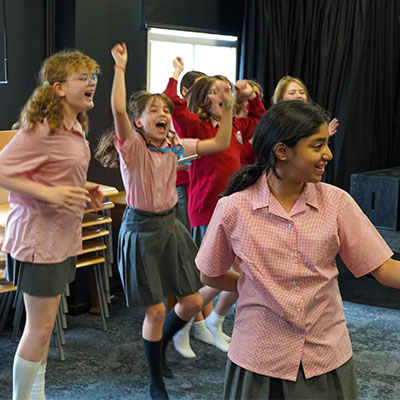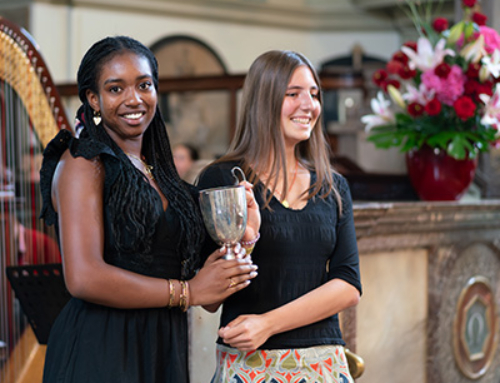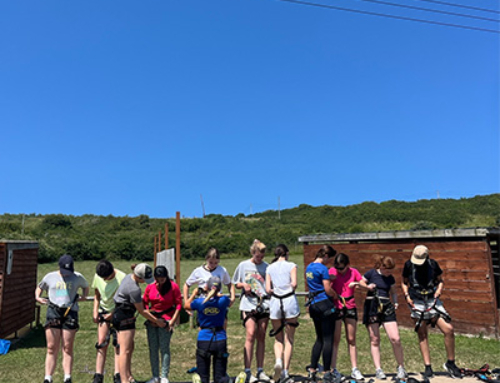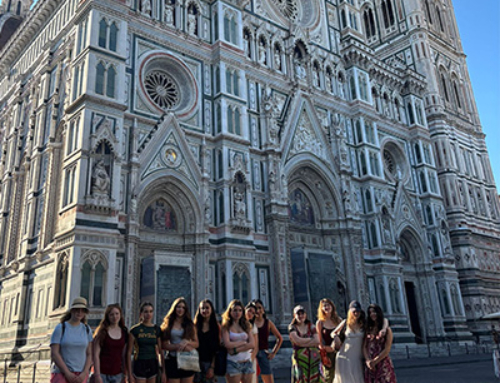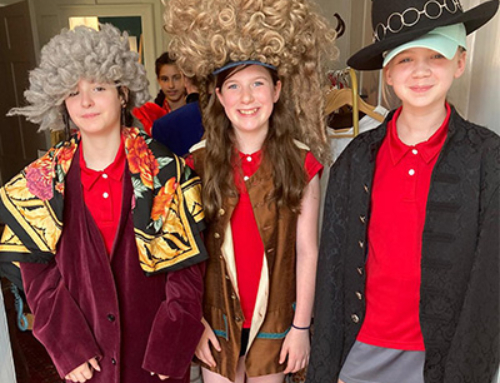It’s Discovery Week!
This week the Thirds have been focusing on The Arts with trips to galleries, Shakespeare-themed workshops back at School and a trip to Shakespeare’s Globe. Click the below toggles to read more from our student journalists…
On Monday, we went on a very enjoyable trip to Tate Britain and the National Portrait Gallery.
At Tate Britain, we looked at some great paintings, my favourite being ‘The Deluge’ by the artist Winifred Knights. The picture showed a large crowd of panicked people fleeing from a flood. What I found particularly interesting was that Knights had been in a similar situation to the one told by the painting – she had witnessed the Silvertown explosion – the largest explosion on British soil during the First World War. Perturbed after such an outburst, she decided to express her feelings through the Deluge. She, indeed, painted herself into the picture! Knights was at the front of the picture, on the foreground, staring in horror at the water surging forward. The other figures in the painting were looking towards the front as they fled rather than back at the waves coming to swallow them. The fact that she was looking behind her represents how she witnessed the explosion in real life. Also, since her head was turned, we could clearly see her facial expression and the emotions she felt. It helped us to actually see how Knights visualised herself. She also put her mother, Mabel into the painting, pulling a young girl to safety. The young girl modelled Winifred Knights’ younger brother, who died in 1915. This may have shown how strongly Mabel Knights felt for her children and her longingness and devotion to keep them safe. The artist unquestionably felt her mother was an incredibly devoted and selfless person. Overall, I found it fascinating to see Winifred Knights’ interpretations of herself and her mother.
At the National Portrait Gallery, we looked at Georges Seurat’s tour de force ‘Bathers at Asnières’. We noticed that, if you take into account what is going on in the picture, you can see that in Seurat’s painting, the day of the week is a Sunday. There were a number of tiny details to tell us this. For one, in the background of the paintings there are factories, and only one is letting off smoke. This tells us that most people are off work. Another clue to it being a Sunday is that men are relaxing in the picture, but no women. We can guess that the women are having Sunday lunch together. The picture also makes us aware of the pecking order back in the writer’s time; the people on the grassy banks relaxing are the working class men and the people fortunate enough to take a boat out are the upper class men.
I have learnt that zooming in on the smallest of details hidden in paintings helps us to feel the artist’s feelings and see through their eyes. I have also learnt that it helps to know the history of the artist who produced the painting. This unforgettable experience has changed the way I will ever look at a painting from now on!
On Tuesday, we had a great art workshop. When we went to Tate Britain and the National Portrait Gallery the day before, we were given small books so that we could record any ideas we had about paintings and the thoughts and feelings they gave us. We also drew pictures of the paintings and sculptures we saw. In the art workshop, we were able to use the drawings and ideas we had to make a collage about our trip or use bits of paper to recreate the artwork we copied into our books. It was great fun!
On the previous day at Tate Britain I drew a picture into my book of a sculpture of a man with beads coming out of his head. This peculiar piece of work was unique yet gave the audience a tad of uneasiness looking at it. It was different from what you would usually see in an art gallery. Hence, at the workshop I decided to use this as an inspiration to make a collage of a tiger with tree branches coming out of its head. I cut out the tiger from a picture of Rousseau’s very eye-catching painting ‘Tiger in a Tropical Storm’. I cut some tree branches out of the painting as well and stuck them onto the paper so that they came out of the tiger’s head. I feel like this in a way matched the sculpture I saw because they both gave me the same feelings – curiosity and slight discomposure.
It was really fun to reflect on what we saw at the art galleries and it kept our minds working, which felt very fantastic. Overall, I really enjoyed it!
Haleema D
Today my class and I went to two art galleries (Tate Britain & National Gallery).
I saw lots of amazing pieces of art ranging from sculptures to paintings to papier-mache people. My favourite painting I saw was an oil on canvas piece from the French artist George Pierre Seurat. This is a painting showing multiple people relaxing by the bank of a river. In this painting you can also see other people enjoying the same lake by boat. You can see factories on the horizon when you look at it. However there isn’t any grey smoke coming out implying its either a Sunday or a bank holiday. What I liked about this painting is although the shapes are simple they are all flowing and smooth curvy lines. Seurat has used pastel colours really effectively making them all stand out even though they still are faint colours themselves. I also like the brush strokes he makes making the grassy bank riverside very realistic.
Alice C
We took the Jubilee line on the train from Baker Street to Green Park then we took the Victoria line to Pimlico. We walked the rest of the way to Tate Britain. When we arrived, we went up a staircase and came into a room full of old paintings.
Ms McDonnell showed us a painting called ‘Jesus in the House of His Parents’ from the 19th century by John Everett Millais. The painting shows Jesus with blood on his hand and feet as a young child in the house of his parents. As well as having blood on him, there is a cross scratched above him, representing his fate. We also looked at a painting called ‘Ophelia’, by the same painter, which is based on a scene in Hamlet. We drew some of the paintings in the room and explored more. We also looked at a really cool installation piece called ‘The Procession’ by Hew Locke. Then, we went into another room with more modern artwork and studied some of those paintings.
On Monday after lunch we took a Clipper on the Thames to the National Gallery. At the National Gallery, we looked at a painting called ‘The Supper at Emmaus’ by Michelangelo Merisi da Caravaggio and another one called ‘An Experiment on a Bird in the Air Pump’ by Joseph Wright of Derby. Just as Ms MacDonnell was talking about that painting, two people came in from the organization ‘Just Stop Oil’ and stepped behind the barriers of ‘The Hay Wain’ by John Constable. Their names were Hannah Hunt (23) and Eben Lazarus (22). They got out three rolls of paper and covered the painting with them. It was the same painting but depicted the future if the government carried on building new oil and gas projects. It showed airplanes in the sky and forest fires on the ground. The lake is replaced by a road and there is a truck riding on it. They also superglued their hands to the frame of the painting. ‘I want to work in the arts, not disrupt them, but the situation we’re in means that we have to do everything non-violently possible to prevent the civilization collapse that we are hurtling towards’ said Eben. They spoke about how people are getting hurt because of this and how it is destroying the planet. Hannah said: ‘Yes, my hand is glued to this painting, but there is blood on the hands of our government.’
Gabi C
On Tuesday, the Thirds were lucky enough to have an interesting English workshop lead by Mr Anderson. As the Thirds are looking at Shakespeare’s great tragedy (often dubbed the greatest love story) Romeo and Juliet¸over the course of the workshop we discussed the plot of Romeo and Juliet and wrote our own pieces of Re-Creative Writing.
In the Re-Creative Writing, we re-wrote a scene of Romeo and Juliet in the form of a poem, playscript or story extract with different characters, setting or time. In order to get us inspired, we looked at some re-tellings such as popular book by Malorie Blackman, Noughts and Crosses, blockbuster film West Side Story and a slightly odd version featuring two rival ice cream vans. We then wrote our own retellings in settings such as space, WWII, Cats and Dogs (rather than Capulets and Montagues) and even in the Cold War! Here are some extracts from our class writing. . .
Cold Love
Her boots sank into the mud dragging her down. She carried on. The squelching sound of walking was soon drained out by a cloud of bullets. She was a prodigy soldier, her training reminding her of the job that needed to be done. Her eagle eyes scanning the perimeter hoping for someone. Out of the corner of her eye she saw something. It was as if it was calling to her, urging her to come over. Natasha walked up to the figure, her arms swaying carelessly. The figure mumbled softly. “America,” it said. She lifted her gun, the mud engulfing her shoes. The figure turned. Its eyes were glistening, pleading for mercy. He was a boy, a young one only about 19: close to her age. She put her finger on the trigger. . . by Anonymous, IIIT
. . . I can remember almost tripping over a bit of metal. Cold against my already shivering bare leg. I can remember Mum breathing “What is it?” And me pointing with a trembling finger towards the plane wreckage where there was a symbol, a small terrible symbol that we all knew now. The Swastika. It seemed Hitler had paid us a visit after all.
I can remember poking into the plane wreckage, looking for a survivor. Mum and I were both thinking and praying the same thing, I knew it. ‘Oh God let him be alive.’ Then relief. We found a boy, the most beautiful boy I had ever seen. He had eyes like two pieces of night sky and hair like gritty sand. His thick eyelids fluttered (he had a nasty gash down his side and was barely conscious) and his parched lips formed two words, the two words she vowed to remember forever. “Help me.” by Sarah M
Thank you to Mr Anderson for running the incredible workshop!
Sarah M
The Thirds were lucky enough to have a company come to FHS and do an amazing workshop for us all. The workshop was fun, informative and very interactive. We worked on West Side Story. This is a film and production based on the original story of Shakespeare’s Romeo and Juliet. What I found particularly interesting is that instead of an ancient grudge between two households, it is between two gangs. These two gangs are called the Sharks and the Jets who have 2 different beliefs.
In the workshop we did multiple activities which involved learning songs and dances to different songs that are in the original play. In the workshop we also learnt some acting which involved groups of six doing a still image of a snippet of each scene. We were always given constructive criticism from the professionals on things like varying heights, facial expressions and wariness of blocking other actors. We all certainly learnt a lot! What I loved about the dance choreography was that it was accessible and everyone could do it.
Just before break time, we were surprised with an incredible duet from the facilitators! They sang the song from the famous balcony scene. It certainly didn’t disappoint. For the second part of the day, we learnt two different songs. It was really exciting to learn the vocal warm ups that people do before proper productions! We did two different songs with different parts and different styles.
The last part of the day was called the showcase. The two groups came together and put all the still images, songs, dances and narration together. It was really nice to be able to ‘show off’ all our work to the teachers.
I would like to say a big thank you to everyone who helped make the workshop possible!
Alice C
Today, we went to the Globe Theatre, we took the train to the south bank of the River Thames and walked the rest of the way to the Globe.
A man showed us in and told us he would be our tour guide and workshop instructor for the morning. He took us inside the Globe to one of the near-top seats. He talked about how different the building was compared to modern theatres, he also mentioned that the theatre was not in its original place, as they had to move the original due to problems with their landlord. They had to move the Globe in bits and pieces across the Themes to rebuild it in the place it is now. After he had finished talking, he showed us out of the Globe and into another building where we did our workshop. In the workshop, we practiced changing our tone of voice in acting when trying to convince someone to do something. We also got into pairs and acted out a shortened scene from ‘A Midsummer Night’s Dream’. After the workshop, we went out onto the grass outside Tate Modern and had our lunch. When we had finished lunch, we took the train back to school. At school, we had form time and then went to the Drama Studio to watch the first half of Romeo and Juliet filmed in the Globe. We collected our bags and headed home!
Gabi C
On Thursday, the Thirds visited Shakespeare’s Globe. We took the tube to Southwark and walked to the Globe from there. Once at the Globe, we were immediately greeted by our enthusiastic and knowledgeable tour guide, Al. We discussed how old the Globe was and why it was built on the south side of the River Thames rather than the north. (Try researching these questions!)
Upon entering the Globe building, we climbed a musty staircase and arrived on a balcony facing the Globe stage. A breath of awe was conducted in unison as we all gaped at the majestic beauty of the Globe. It seemed that the spirits of all the actors who had performed there and all the audience members who had watched a performance there were hovering with us in the thick summer London air. We seated ourselves comfortably on the balcony, gazing down at the stage where we learnt about the Globe was built and why and where everyone would have sat in Shakespearian times to watch a performance. We also discussed how special effects would have been created.
After an amazing tour, we crossed the road to a nearby studio (my friends and I were debating whether it smelt of Twister ice lollies or bleach) where we had an entertaining and interesting workshop. Then, it was time for lunch and we sat on the Southbank and had a memorable and lovely picnic. It was time to head home after a perfect morning of Shakespeare.
That afternoon, all the Thirds gathered in the Drama Studio to watch a recording of Romeo and Juliet being performed at the Globe. It was satisfying to see our week’s work come into one performance, all of our knowledge gathered from the trips and workshops came into it as we watched. Though we may not have got to finish the whole thing, it was a brilliant way to end Discovery Week and I thoroughly enjoyed myself.
On behalf of all the Thirds, I would like to say a massive Thank You to all the teachers who accompanied us on trips, all those who ran workshops for us and those who helped put an amazing Discovery Week together. Thank you, all!
Sarah M


